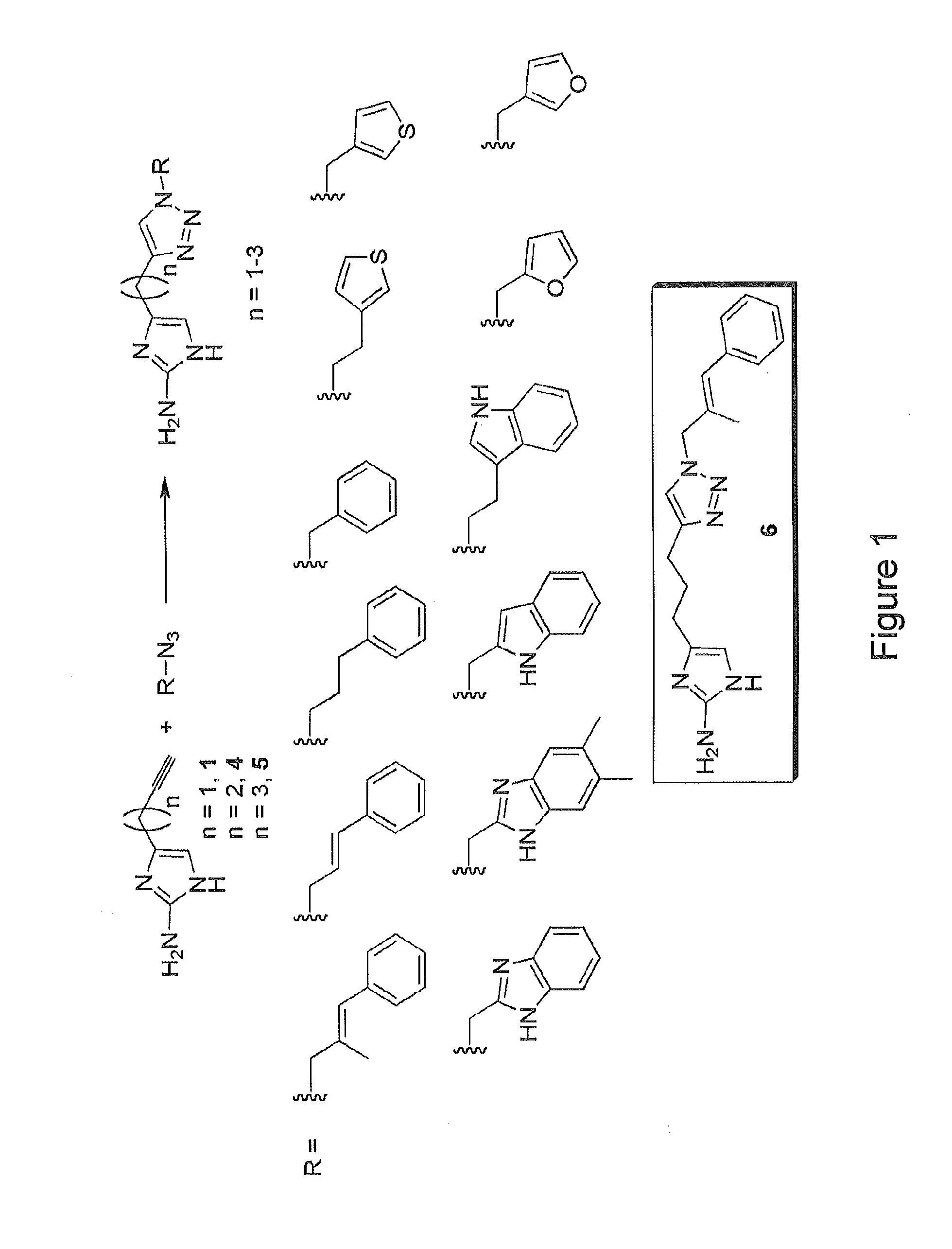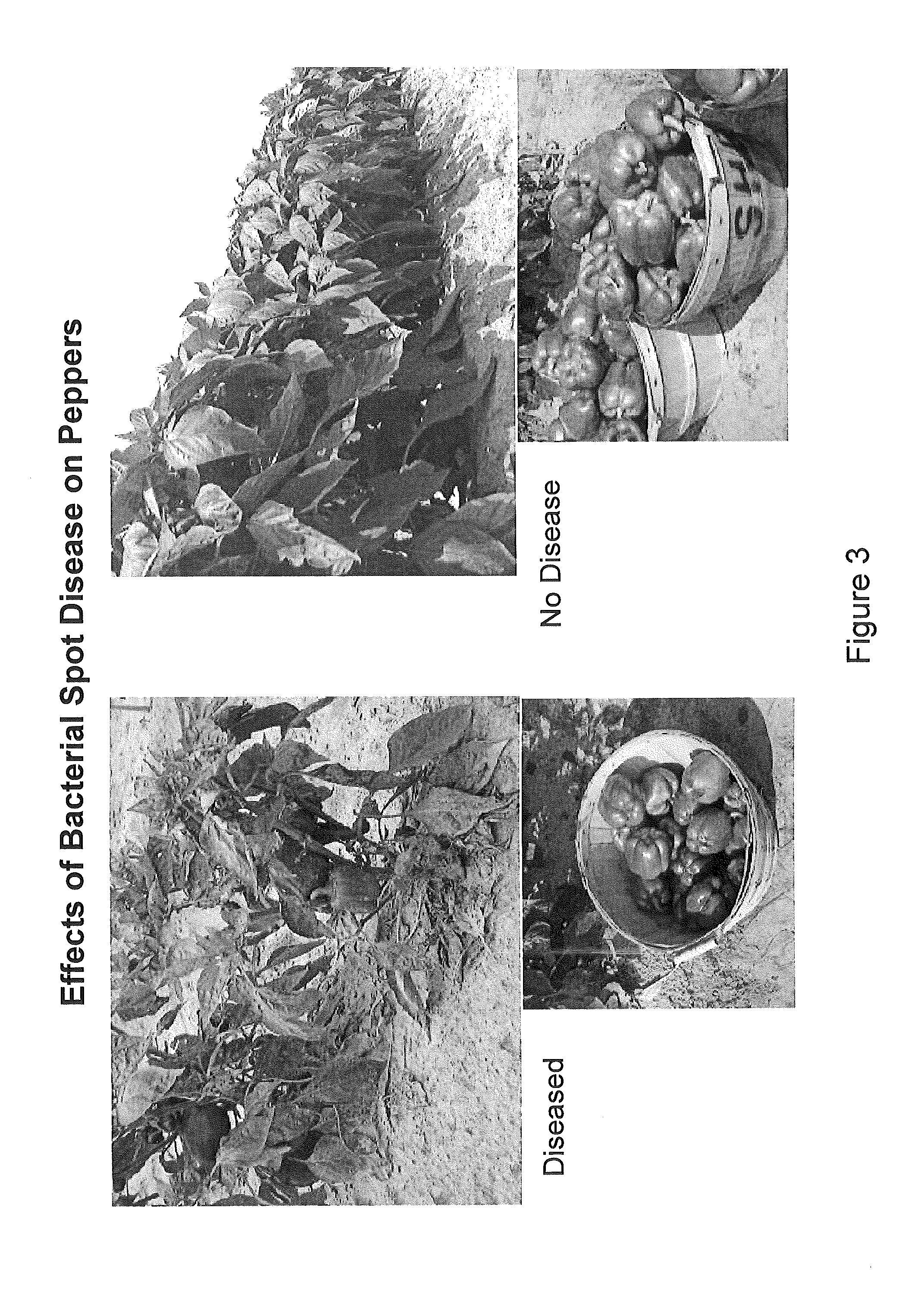Inhibition and dispersion of biofilms in plants with imidazole-triazole derivatives
a technology of imidazole and triazole, which is applied in the field of inhibition and dispersion of biofilms in plants with imidazoletriazole derivatives, can solve the problems of affecting all crops in a deleterious manner, forestry crops and ornamentals also suffer from biofilms, and achieve the effect of enhancing the effect of a plant defense activator
- Summary
- Abstract
- Description
- Claims
- Application Information
AI Technical Summary
Benefits of technology
Problems solved by technology
Method used
Image
Examples
example 1
Synthesis of 2-Aminoimidazole-Triazole (2-AIT) Chemical Library
[0323]There is a paucity of reactions that have been reported to be compatible with 2-aminoimidazoles. To test the applicability of the Cu(I)-catalyzed [3+2] alkyne / azide cycloaddition (Click reaction, see Kolb et al., Angewandte Chemie-International Edition 2001, 11, 2004-2021; Rodionov et al., Angewandte Chemie-International Edition 2005, 15, 2210-2215), we synthesized the alkyne derived 2-aminoimidzole 1 and tested its ability to participate in a Cu(I)-catalyzed [3+2] cycloaddition with benzyl azide.
[0324]The alkyne derived 2-aminoimidazole (2-AI) was synthesized as outlined in Scheme 1. Amino acid 2 (Kotha et al., Tetrahedron 2002, 45, 9203-9208) was subjected to small scale Akabori reduction (Akabori, Berichte Der Deutschen Chemischen Gesellschaft 1933, 66, 151-158), which, followed by condensation with cyanamide (Xu Yz et al., J Org Chem 1997, 3, 456-464) delivered the target alkyne 2-AI 1 in 88% yield. With 1 in h...
example 2
Activity Testing of 2-AIT Library Members
[0381]A Standard Crystal Violet reporter assay is employed to assess the effect of compounds from the 2-amino on the formation of biofilms. Among others, the following strains are tested:
[0382]Xanthomonas Xccl
[0383]Xanthomonas Xcv.135
[0384]Xanthomonas Xcv5
[0385]Xanthomonas Xccp
[0386]Xanthomonas Xcp60
[0387]Xanthomonas Xcp25
[0388]Ralstonia solanacearum K66
Xanthomonas is a Gram-negative rod-shaped bacterium that is a common plant pathogen. Xanthomonas bacteria grow almost exclusively in plants. Xanthomonas species testing includes X. vesicatoria (crop=tomato), X. euvesicatoria (crop=pepper), X. campestris (crop=crucifers, particularly cabbage), X. zinniae (crop=zinnia), and X. fragariae (crop=strawberry). Ralstonia solanacearum is a Gram-negative bacterium that is found in soil.
[0389]Bacteria are allowed to form biofilms in a multi-well plate in the absence or presence of one or more compounds. Planktonic (or free growing) bacteria are then remo...
example 3
Activity Testing of 2-AIT Library Members on Xanthomonas
[0390]Biofilm formation on PVC microtiter wells was accomplished using Xanthomonas strains Xcv 135 (known to infect peppers and tomatoes) and Xcv 5 (known to infect tomatoes but not peppers) as models. The Starting Optical Density (OD at 600 nm) for biofilm attachment assay was 0.55, the temperature for this assay was 28° C., the duration of incubation was 6 hours under, and the assay was static.
[0391]Biofilm inhibition results are as follows for screens with Xcv 135. The Xcv 5 strain is tested in the same manner.
Compound Screened% Inhibition at 20 μM (vs. Xcv 135)Formula (II)(a)(5)(D)86%Formula (II)(a)(6)(D)85%Formula (II)(i)(a)(2)(J) 0%
PUM
| Property | Measurement | Unit |
|---|---|---|
| temperature | aaaaa | aaaaa |
| OD | aaaaa | aaaaa |
| compositions | aaaaa | aaaaa |
Abstract
Description
Claims
Application Information
 Login to View More
Login to View More - R&D
- Intellectual Property
- Life Sciences
- Materials
- Tech Scout
- Unparalleled Data Quality
- Higher Quality Content
- 60% Fewer Hallucinations
Browse by: Latest US Patents, China's latest patents, Technical Efficacy Thesaurus, Application Domain, Technology Topic, Popular Technical Reports.
© 2025 PatSnap. All rights reserved.Legal|Privacy policy|Modern Slavery Act Transparency Statement|Sitemap|About US| Contact US: help@patsnap.com



